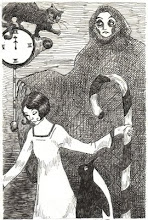
The city is an island.
This geographic fact distinguishes New York from most of the other world capitals. London and Paris expanded beyond their ancient city walls centuries ago. Houston and Los Angeles are all sprawl. In New York, there isn't much opportunity for building out. Up and over are really the only possibilities. Genteel decay is never in fashion here, there's no room for it.
"Beautiful things grow to a certain height and then they fail and fade off, breathing out memories as they decay. And just as any period decays in our minds, the things of that period should decay too … That graveyard at Tarrytown, for instance. The asses who give money to preserve things have spoiled that too. Sleepy Hollow's gone; Washington Irving's dead and his books are rotting in our estimation year by year--then let the graveyard rot too, as it should, as all things should. Trying to preserve a century by keeping its relics up to date is like keeping a dying man alive by stimulants … Would you value your Keats letter if the signature was traced over to make it last longer?"
I've always loved this passage from F. Scott Fitzgerald's The Beautiful and Damned. I don't know that I disagree with the beautiful Gloria that the preservation of places is sometimes like painting a corpse. We New Yorkers are also Americans and prefer to relegate our history to myth, we are a little uncomfortable with having it in front of us. We aren't very good at either preserving the past properly, or of letting it decay.
All this self-indulgence brings me to the bar at The Gramercy Park Hotel. Before Ian Schrager bought the place and made it over in his glossy image, I used to go to the bar in the lobby all the time.
To make a full disclosure: I love hotels. Love them. But as I've always lived in NYC, I've never really stayed in any of the hotels here - although I've been tempted. Rent a room! Pretend to be someone else! It's awfully appealing, but the post-9/11, post-Patriot Act realities are spoiling everyone's fun and taking away every American's given right to reinvent themselves at will. The ability to simply get on a train and travel somewhere else, to step out of one's own life and decide to become someone else is now a part of our mythic collective past. Flitcraft would have had to stay where he was and go to therapy.
All we have left to us are hotel bars. They still retain the glamour that is created by impermanence. No identification is required. You can be whoever you want.
But, wait - stop. This romanticizing of transience is becoming nearly all I write about. Abandoned children who dream of a pirate past, an itinerant criminal whose seedy existence is glossed over with dreams of '40s technicolor, a journey to a made-up Antipodean continent, a foundling whose adopted mother dreams forever of faraway places. I've never been anywhere without wanting to move on to the next place. As an adult, I hated the ending of the movie version of The Wizard of Oz. "There's no place like home". If home is dust bowl and depression blighted Kansas, I say there's no place like Oz!
I've never been very good at self-reflection. I've always loved to travel. Hotel bars are the perfect place to go when one is at home but you would like to pretend to be somewhere or someone else.
The large, dark bar of the Gramercy Park Hotel was somewhere I used to go a lot. Full of ratty couches, ottomans and upholstered chairs, it was comfortable and faded. The hotel was built by Bing & Bing in 1925, Humphrey Bogart lived there for two years and Babe Ruth apparently loved the bar as much as I did. The hotel was a center of New York bohemianism, waxing and waning through the years in the usual bohemian cycles. The first season cast of Satuurday Night Live lived there, as did Edmund Wilson, Margaret Hamilton (the good witch of Gramercy Park) and James Cagney. Through the 70's and 80's lots of bands stayed in its shabby rooms, including Blondie and the fictional Stillwater.

Ian Schrager scooped up the Gramercy's decaying glory in 2003. Julian Schnabel designed the new interiors. One of the reviews on travelfinder said the place felt like a movie set - they aren't wrong, the place feels as if it is trying a little too hard, it's too expensive for actual artists or writers or bohemians of any stripe, but it is designed to make rich out of towners feel as if they are in the real New York. It's entirely erzatz, and although the art on the walls is real, the hotel feels as if it isn't. Maybe I'm just grumpy because the bar prices are ludicrously expensive.
Things in this city decay or they are rebuilt. They never entirely disappear. The ghosts remain. I sat in the bar with a friend sipping a $19 glass of Riesling. It was still dark, and full of no longer shabby upholstered furniture and banquettes. But the mystery is gone and the ghosts are awfully uncomfortable.
















